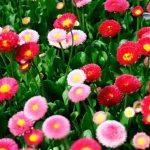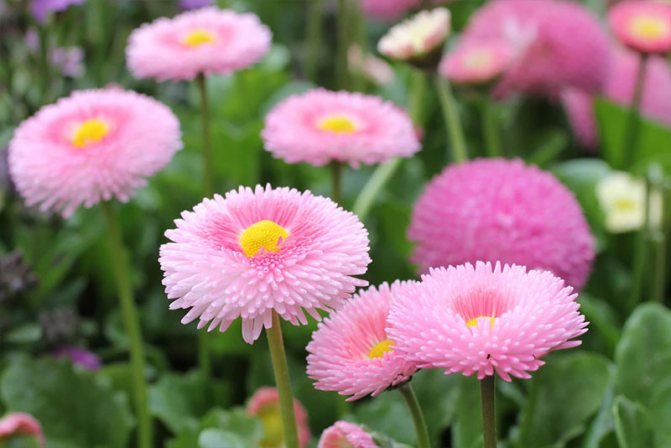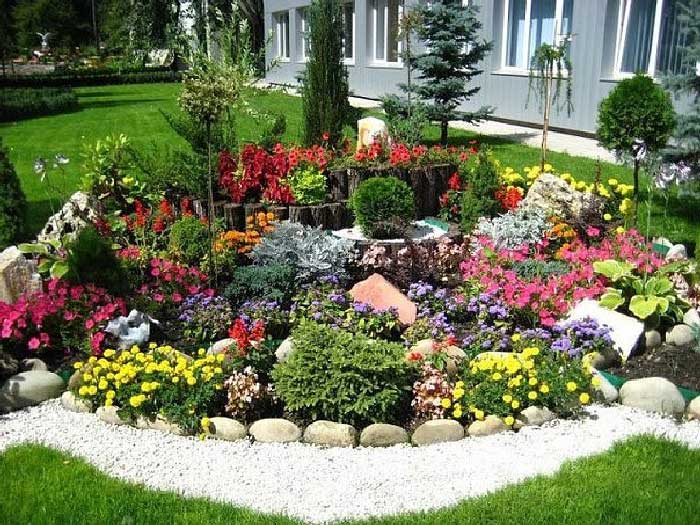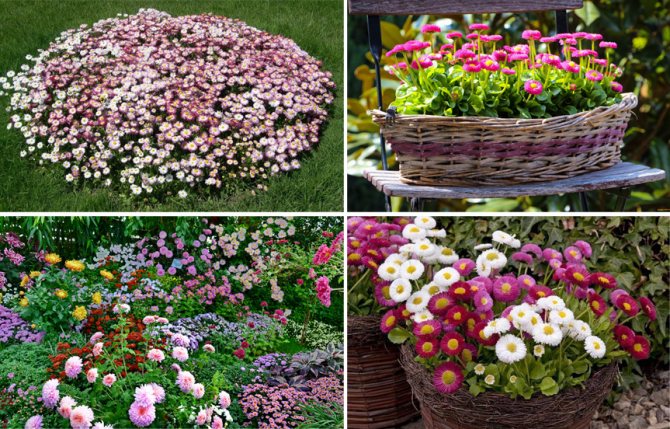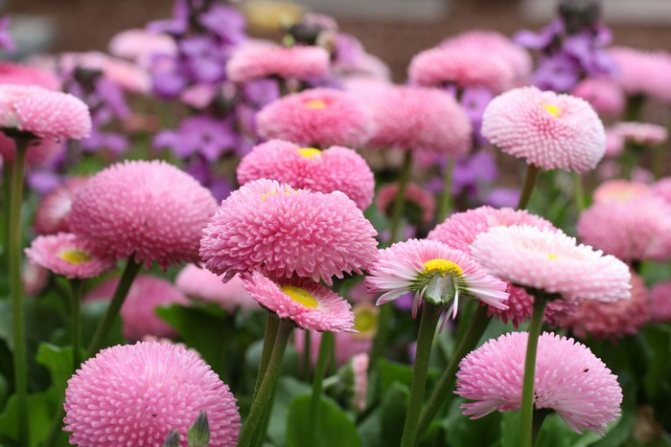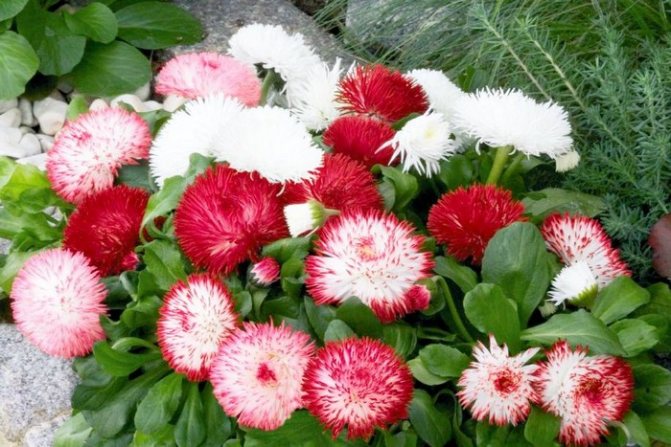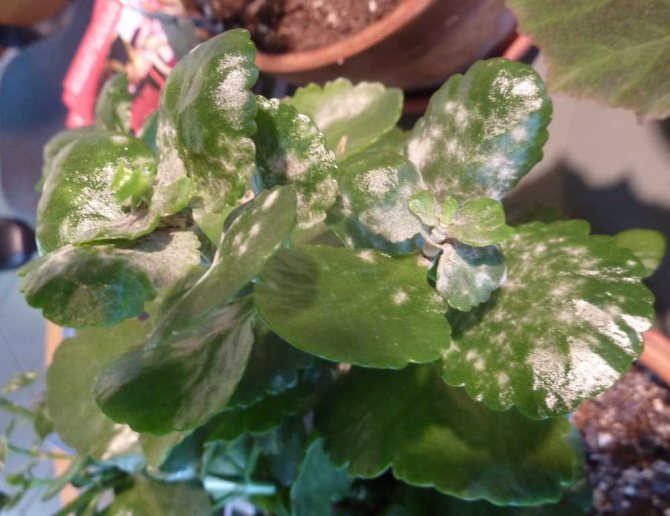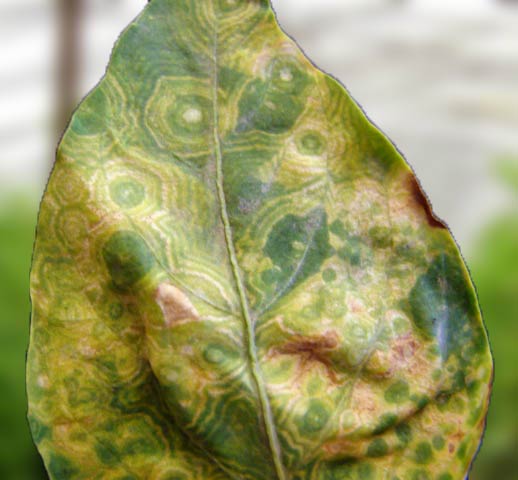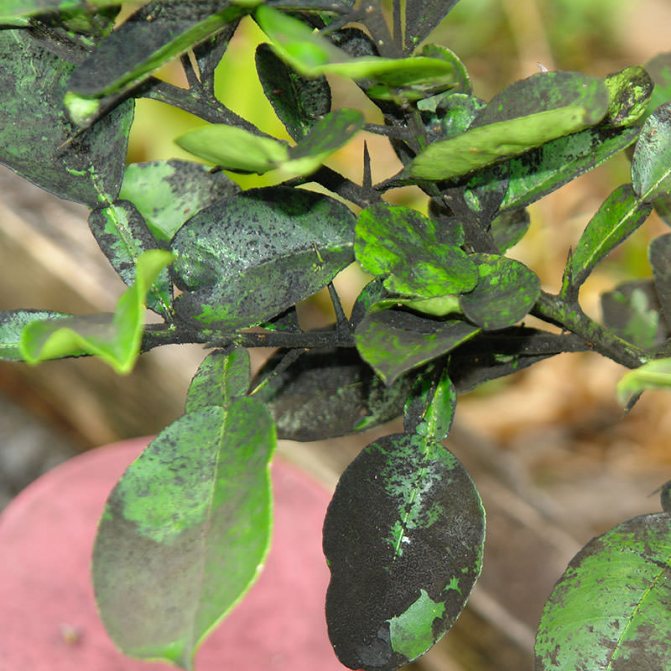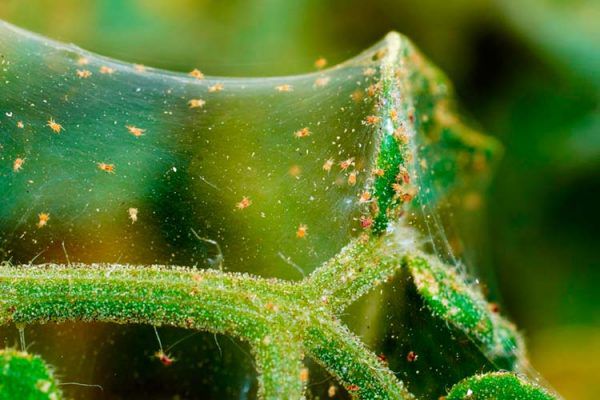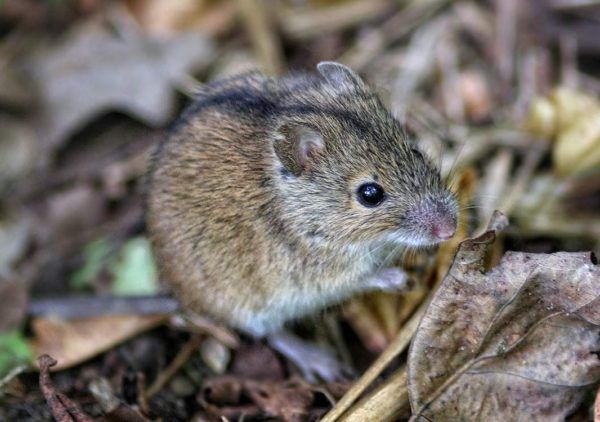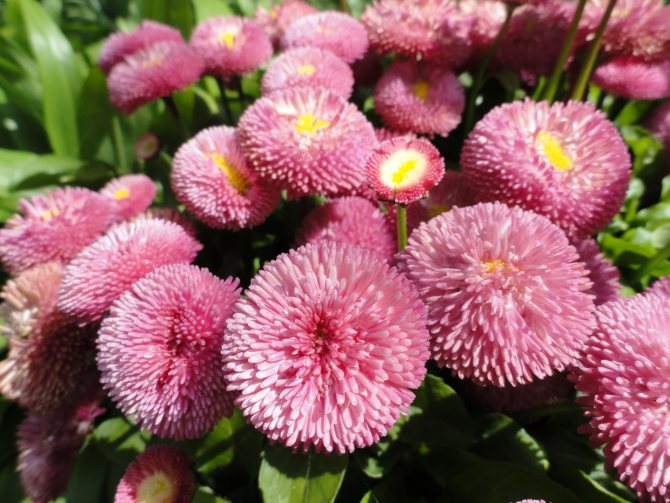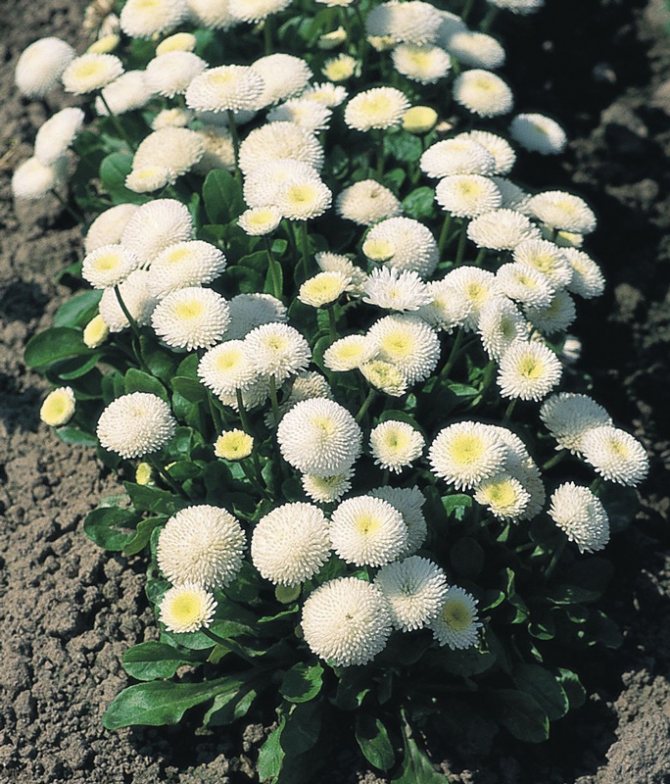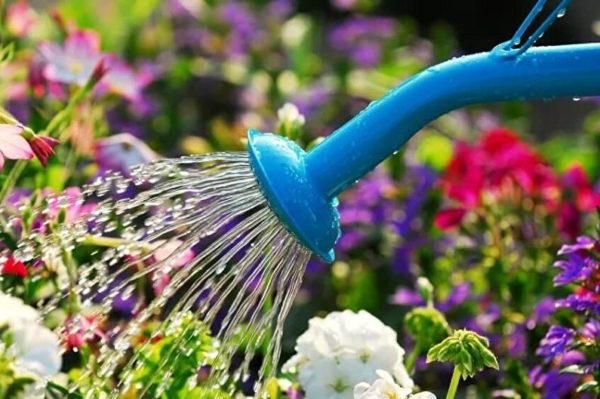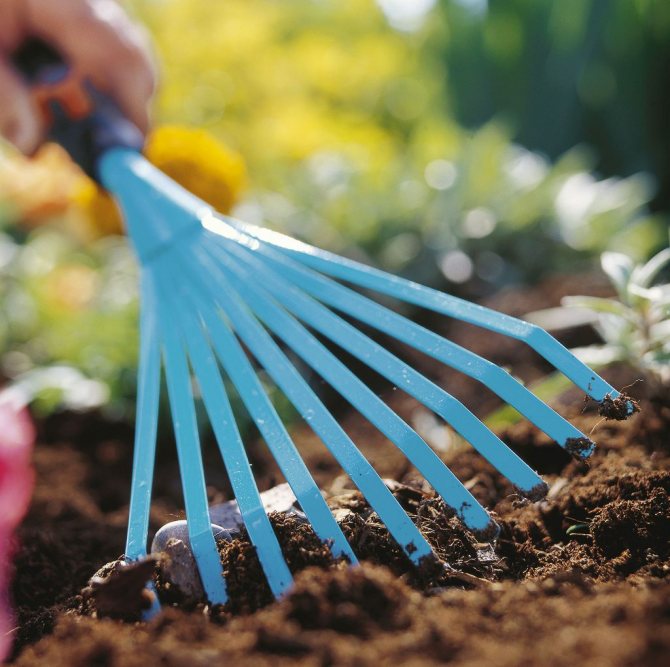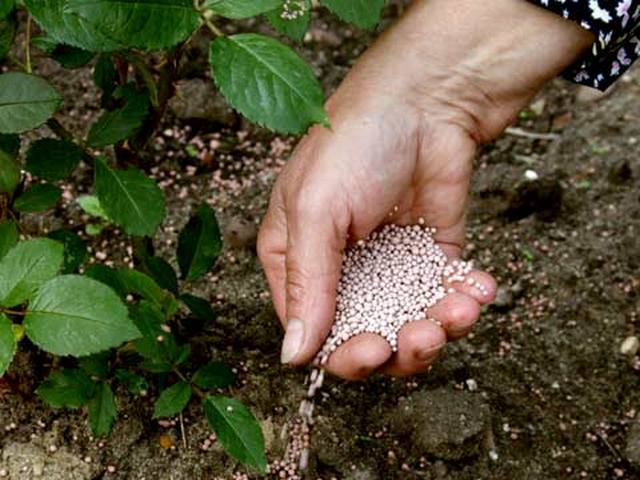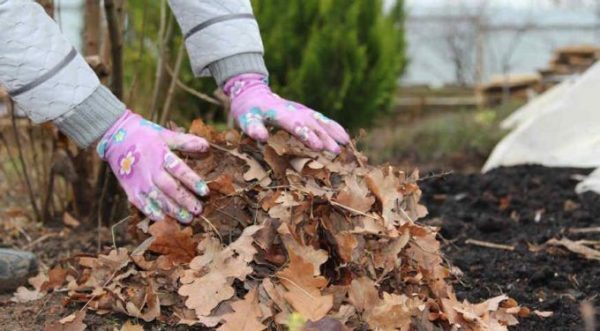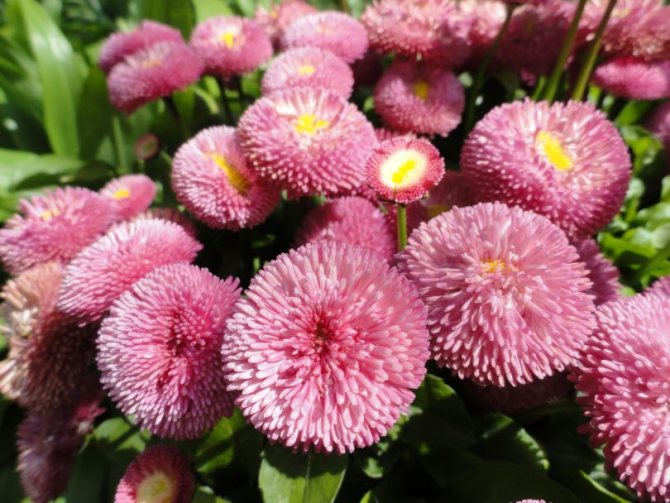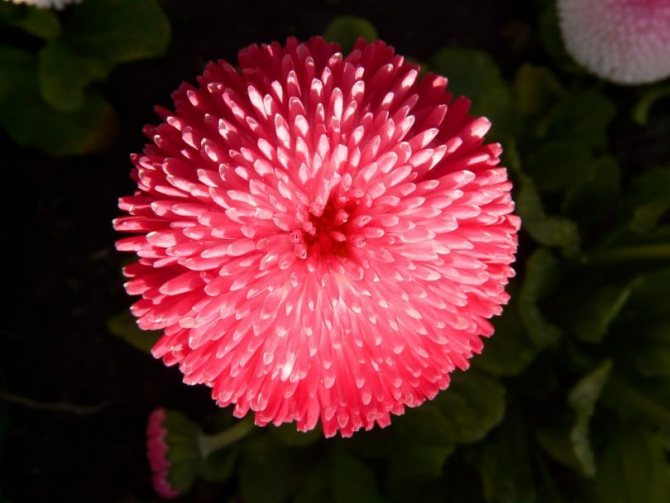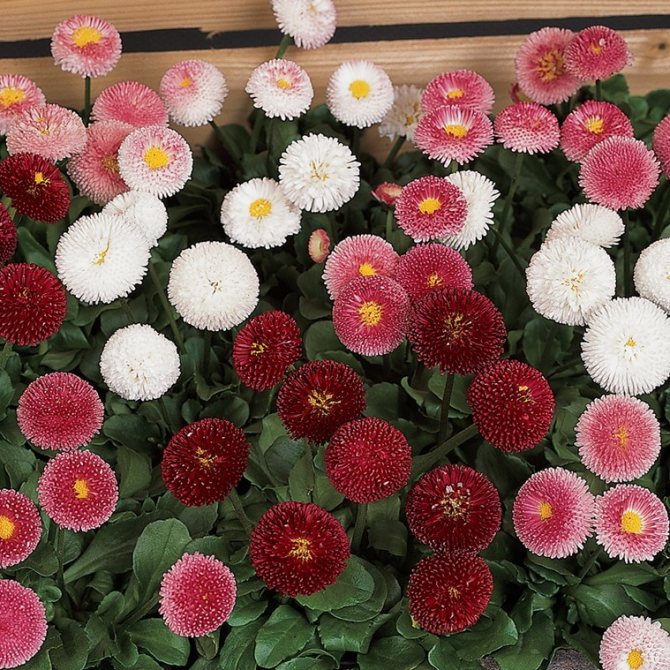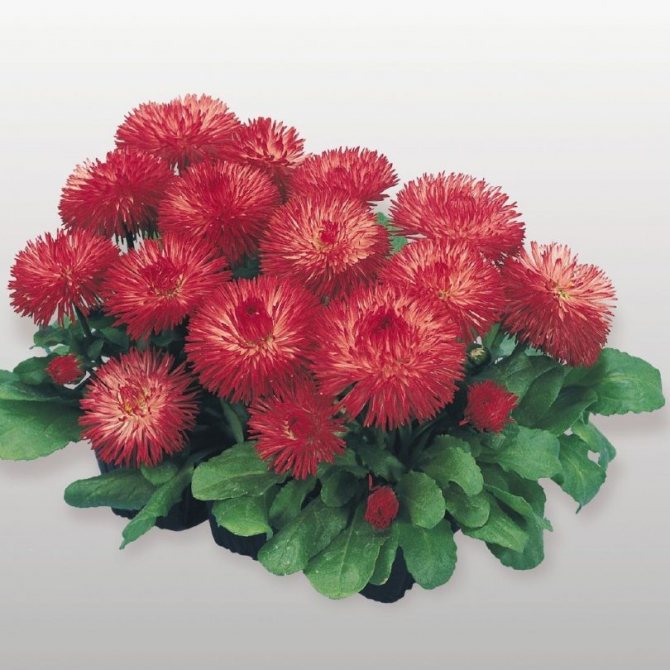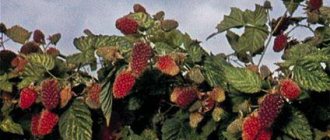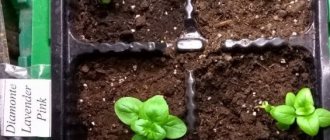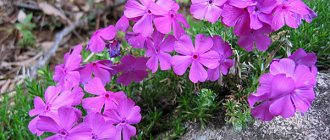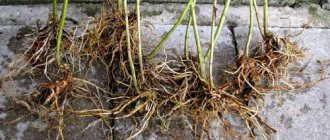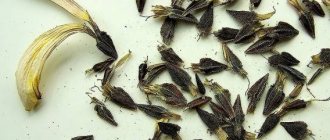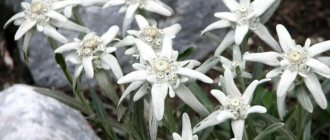Mostly a perennial plant with expressive double inflorescences. Thanks to its bright appearance, it has become an integral attribute of landscape compositions. Named by analogy with one of the most beautiful human names. An incredibly undemanding culture to care for. The listed characteristics refer to a flower called Perennial Daisies. Planting and care, as well as the features of their reproduction, are discussed in the article.
Perennial daisies: planting and care
general description
Daisies look beautiful not only in bloom, their unusual lobe-shaped leaves delight the eye with luscious greenery from early spring to the very frost.
Daisies belong to the Astrov family, there are officially more than 80 species of this biennial, which are rooted in the countries of Europe, America, Australia. They were the first to make their way from fields to gardens; by the beginning of the 16th century, there were several terry varieties in the selection.
They were cultivated in the palace parks of England, France, Italy. Flowers quickly spread to city parks, and not only white, but also red daisies were known.
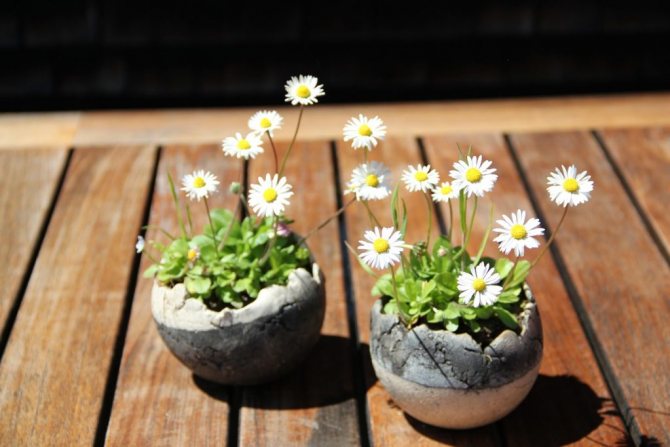
Daisies in decorative pots
From Latin, daisy translates literally as "pearl", this is how these flowers on lawns look when they grow among low grass. A well-groomed flower bed with daisies will look a little different,
The leaves will flaunt with luscious greenery, flowers will delight the eye several times per season. Usually, the first flowering takes place in early spring, daisies take over from tulips and daffodils, the second time Aster of this species will bloom closer to autumn, when the heat subsides and moisture will be enough to restore the vitality of the stem.
It is difficult to confuse a daisy with another flower; it has a number of features:
- Low height, daisies rarely reach 30 cm.
- The leaves sit tightly next to each other, have a lobe-like shape.
- The inflorescence is in the shape of a basket.
- Flowers do not rise much on a rosette of leaves, no more than 3-5 cm.
- The middle of the flower always has a yellow color, it is framed by the outer petals have a tongue or tubular shape.
Each bush at a time can please with 30 peduncles with fully developed flowers.
The stem is classified as Compositae, it is distinguished by the following subspecies:
- simple
- semi-double
- terry
They will also vary in flowering time, there are early and late varieties, the timing differs by 2-3 weeks... The size of the flower also divided the daisies into small, medium and large-flowered varieties.
Daisies with large baskets bloom much later than all their relatives, but the period is much longer.
back to menu ↑
See also: Delphinium Magnificent! Description, varieties, growing from seeds, reproduction, planting and care (45 Photos & Videos) + Reviews
Botanical description of culture
It grows mainly in Mediterranean countries and western Europe. In garden design, it has several functions:
- frames flower beds;
- forms "carpet tracks";
- makes the border of the lawn more decorative.
There are about 15 known varieties of daisies. Gardeners cultivate both annuals growing in pots and perennials growing in gardens.
Daisies go well with daffodils, tulips and other bulbs.
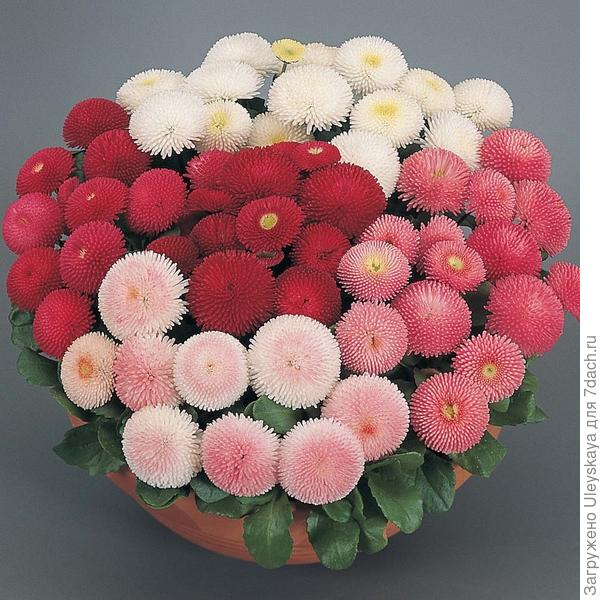

The most common colors are pink, red and white.
From the ancient Greek language, the word "margarites" is translated as "pearl". A similar association is associated with the peculiarity of the appearance of the wild version of the plant. Small snow-white flowers from a distance look like the contents of mollusk shells. In a number of countries, the plant is called the "Eye of the Day". This is due to the fact that the flowers open at the same time as the sun rises.


Daisies are in great demand in the creation of garden compositions.
Daisies have phenomenal meteorological abilities. Before the rain, the inflorescences close, and the stems are pressed tightly to the ground.
Table 1. Main characteristics
| Part of the plant | Description |
| Height | A small bush that grows up to 30 cm. |
| Socket | Basal, in the form of a blade with serrated edges. |
| Stem | Naked, without foliage. At its base there are leaves blunt at the ends. Only 1 head is formed. |
| Root system | Branched, small in size. |
| Basket | According to the features of its structure, plants are classified into tubular and reed. Then they are divided into simple, double and semi-double. The inflorescences contain a large number of serrated petals. The diameter of the baskets is up to 8 cm. They open well in sunny weather. |
| Fetus | Flattened, without a tuft. Ripens from mid-summer to early September. |
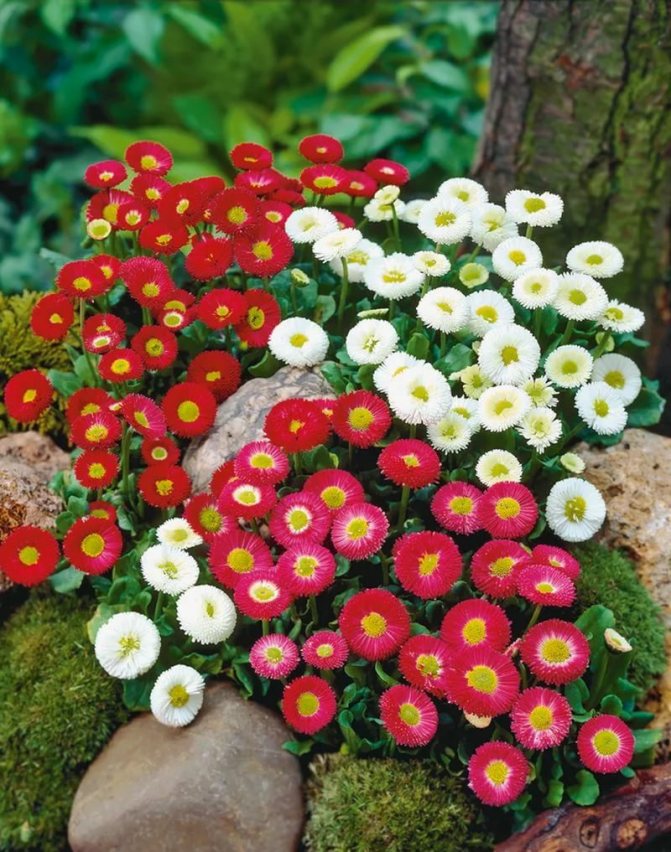

The daisy is the first wildflower to migrate to the garden
Varieties
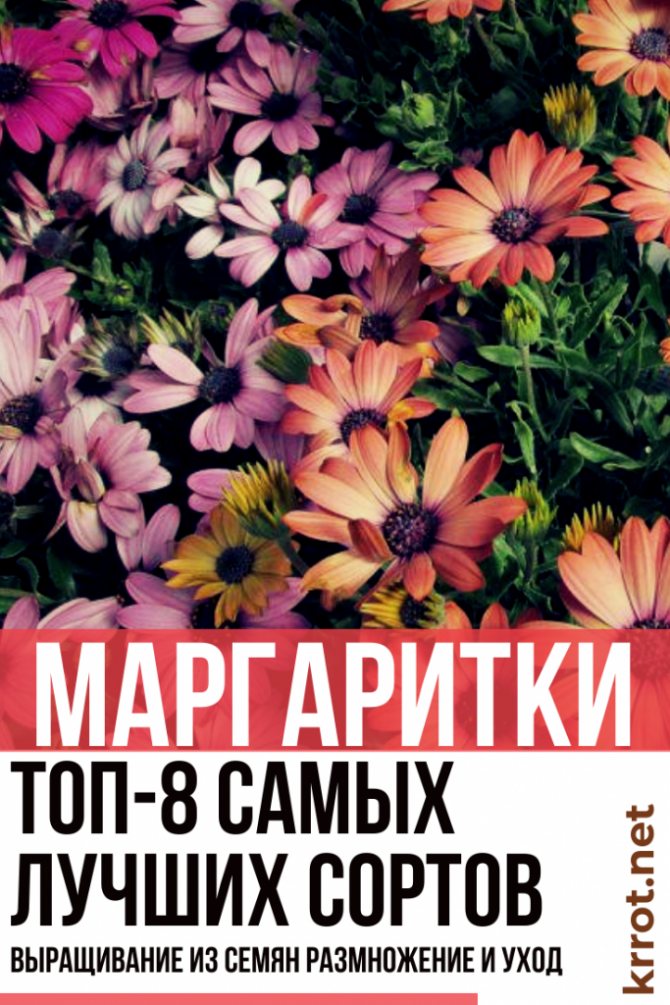

Description of varieties
For decorative cultivation, out of 80 known ones, only 20 are used, which are conventionally divided into seven groups. Each group can include both early and late species, the size of the flower in one group may be different.
The colors of daisies are mainly divided into the following:
- white
- pink
- red
- salmon
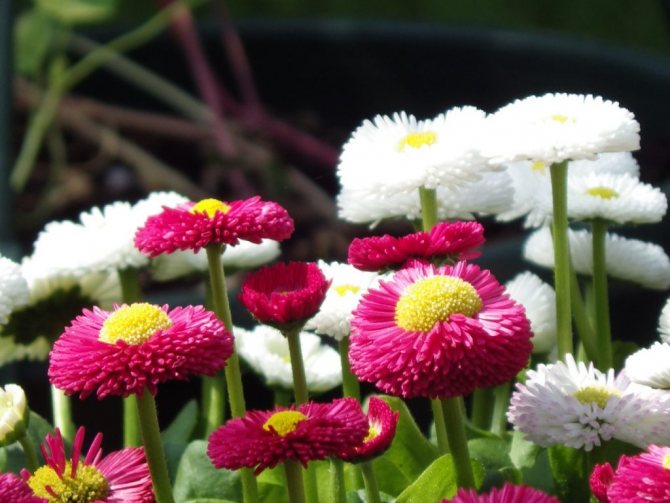

White and red daisies
At the end of the 17th century, two-color varieties flaunted in the gardens and parks of many European countries, the very first was bred and planted in the parks of France, the upper petals were red, while the lower ones remained snow-white.
This country is home to small button pom-poms, which were especially popular in Russia. Very soon, Italy presented lancet varieties with tubular inflorescences for everyone to see.
If you do not care for daisies, do not thin out, do not feed them, they will quickly lose all their decorative characteristics and begin to bloom with ordinary simple flowers, very similar to daisies.
Distinctive features of the variety can be not only flowers, some of them are distinguished by unusual foliage:
- "Aucubaefolia" recognized by yellow splashes on the leaves
- Shrewley Gold has a unique golden pattern on the foliage along the veins
Such varieties will delight the eye along with others in spring and autumn, attracting more attention due to their characteristics.
Among the wide variety of varieties and species, there are the most popular, followed by a more detailed description of them:
back to menu ↑
See also: Carnation - a perennial garden plant: description, types and varieties, methods of growing and reproduction, planting and care in the open field (60+ Photos & Videos) + Reviews
Pests and pathologies
Despite such a miniature size, the plant is resistant to most diseases and parasites characteristic of flowering plants.
Table 3. Diseases and pests
| Disease or pest | Influence on the plant | Solution to the problem |
| It is very rarely affected. It manifests itself through the formation of a dirty gray loose bloom on the petals. | The affected parts are removed. Healthy plants are sprayed with "Bordeaux liquid" or "Topaz" for preventive purposes. |
| Pedicels are stretched in size, and foliage, on the contrary, becomes smaller and loses color saturation. | Injured bushes are dug up and destroyed. The soil in which they grew is disinfected with a solution of potassium permanganate. |
| Formation of a gray bloom on greenery and softening of the stem. | Damaged plants are destroyed, the rest are treated with fungicides. |
| It manifests itself through discoloration of leaf tissue. The plates wrinkle and become rough. The inflorescence baskets look disheveled. | Damaged bushes are destroyed. |
| Plaque formation on flowers and leaves. | Spraying with "Bordeaux liquid". Damaged plants are burned. |
| Rarely attacks daisies. It is characterized by the appearance of white dots on the back of the sheet. | They use insecticidal agents - "Karbofos", for example. |
| Eating out large areas of foliage. | The use of insecticidal solutions. |
| Dark discharge on the back of the foliage. Over time, the leaf plates turn pale yellow. With a prolonged attack of pests, the leaves dry out. | Daisies are treated with insecticides, and sticky blue traps sold in specialized stores are installed against parasites. |
| Gnawed stems and petals of plants. | Poisoned bait. |
Originator Floragran (Floragran)
Daisies of this selection are a novelty among the varieties of this garden plant, but have already been awarded several Fleroselect awards. Floragran (floragran) so far includes only one variety Belladaisy, the rest are under revision.
back to menu ↑
See also: Ranunculus (Buttercup): description, types and varieties, cultivation and reproduction, planting in open ground and care, useful properties (50 Photos & Videos) + Reviews
Belladaisy


"Belladaisy"
- The grown stem is characterized by small baskets of inflorescences up to 2 cm in diameter with strong doubleness, the stems grow up to 10 cm in height.
- Belladaisy tends to fully retain its bright pink petals and bloom approximately 2.5-3 months after sowing.
- When sowing seeds, it is worth considering the weather conditions, if the ground is not sufficiently warmed up, the seedlings will not appear soon.
back to menu ↑
See also: What vegetables can be planted before winter? TOP-8 of the most suitable plants and their best varieties | + Reviews
Plant care
Daisies are surprisingly undemanding. They can even survive drought. The main care procedure, with the exception of watering, is cutting off the faded baskets.
Table 2. Care procedures
Care procedures
| Event | Description |
| It is done several times a week. Regularity is important because the root system of plants is superficial. With a shortage of water, the flowers become smaller in size, and the terry varieties will lose their zest. |
| Mandatory procedure carried out after watering. Promotes better aeration of the roots. |
| Helps to reduce the number of weeding, loosening and watering. It is done immediately after planting plants in open ground. For these purposes, peat is used. Also, this measure prevents the bulging of rhizomes, which inevitably occurs when the soil dries out. |
| Held at least 2 times in 1 season. Complex fertilizers specially developed for flowering crops are considered the best option for plant nutrition. For 1m 2 you need 30 g of solution. |
| It consists in the timely removal of wilted baskets. |
| Daisies are frost-hardy. Small growth allows them to completely go under the snow. If the plants are planted on a hill, from where the wind blows off the snow in winter, it is advisable to organize a shelter with the help of oak leaves.In regions with prolonged cold weather and little rainfall, the plant is insulated with a large layer of mulch, at least 8 cm. |
| Transfer | It is carried out only if the roots protrude from the soil. |
Originator Kieft Seed
The selection is represented by the original variety:
back to menu ↑
See also: Homemade rose in a pot: how to care for it after buying it at home? (20+ Photos & Videos) + Reviews
"Bellissima" (belissima)


"Bellissima" (belissima)
- It is characterized by flowers of a pompom type with a diameter of each up to 5 cm. A dense elastic stem holds the basket at a height of more than 12 cm. All colors are popular, and are red, pink, white, and two-tone types.
- The first flowering occurs in the year of sowing or planting.
- An important point will be the introduction of fertilizers, without them this variety will not be able to give full flowering.
- Some species may have a pronounced yellow core, in most boles it is not visible behind tightly assembled tubular petals.
back to menu ↑
See also: Indoor flower "Bride and groom" or campanula: description, care, reproduction and possible diseases (50 Photos) + Reviews
Reproduction of daisies
It is cultivated both in a generative way, implying planting seeds in the ground, and vegetatively, through cuttings and dividing the bush. The latter method is relevant for varietal plants. Unfortunately, over time, the flowers become smaller and lose their showiness. It is this technology that allows keeping the original characteristics of the variety longer.
Dividing daisies
Scheme of actions:
- The optimal time for the procedure is the last days of August or the beginning of September.
- The plant is removed from the ground and divided into 4 parts.
- Only the stalks are left in the cuttings. The buds, inflorescences are pinched and the leaves are removed. The rhizomes are shortened by 5 cm. This manipulation contributes to better survival in a new area.
Once planted, the plant develops rapidly and blooms in the current season.
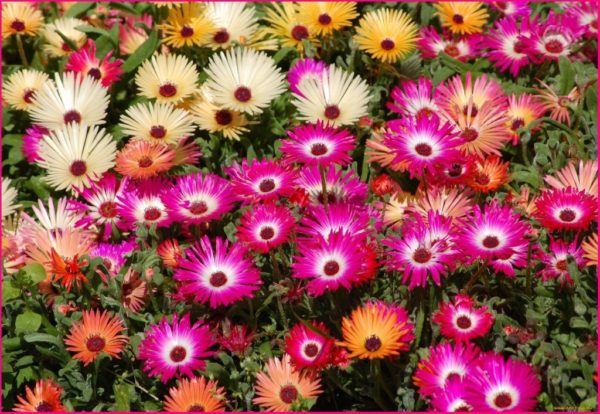

Delenki take root even without a root system
Daisy cuttings
Reproduction using this method is carried out in the same time period as the division of the bush. To carry out the manipulation, a sharpened tool is required, which allows you to carefully cut off the lateral shoots from an adult bush. Sprouts with foliage are planted in loose soil. Rooting occurs after 6 weeks.
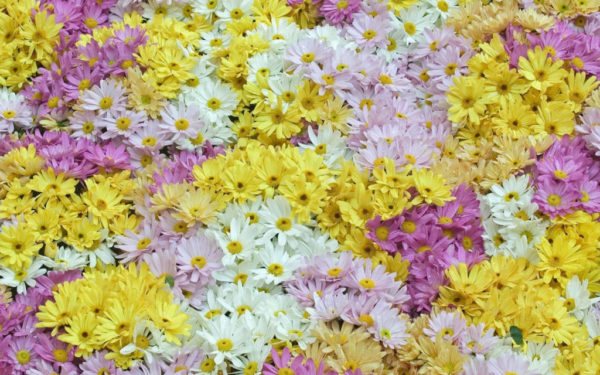

Within the framework of cuttings, inflorescences are formed only the next year
Other varieties
Miniature daisies are considered less common; it is advisable to grow such varieties in small flower beds and should be surrounded with great attention. If not properly cared for, they quickly become overgrown with weeds and become almost invisible in the grass.
These include babies:
- Dresden China
- "Liliput"
- "Alice"
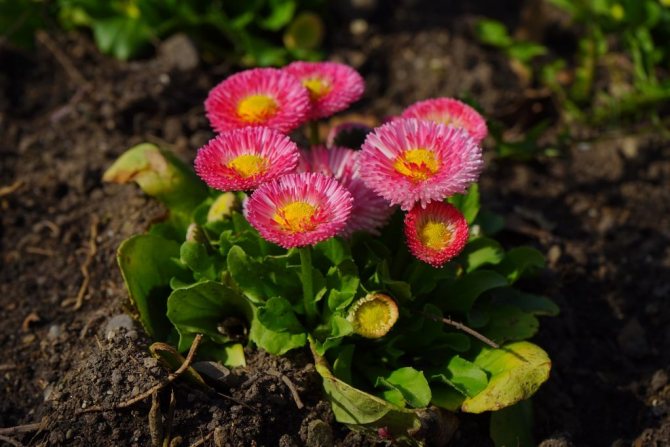

Miniature daisies
These varieties are often planted in public parks in England, they gradually grow in the grass throughout the park. The lawn mower is not afraid of them; when passing it, it cuts off only the tops of the peduncles, the bush itself in this way is stimulated to re-flowering.
I would like to pay special attention to the variety:
back to menu ↑
See also: Rose: description of 16 varieties, features and care - such a different queen of flowers (150 Photos & Videos) + Reviews
Hens and Chickens
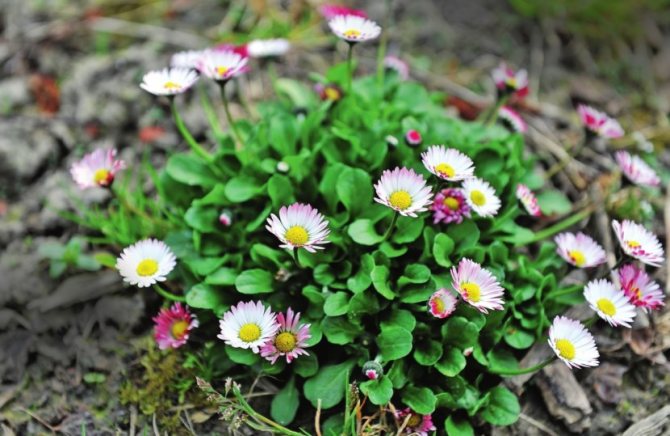

Hens and Chickens
- Which literally translates Hen and Chickens. The main feature of the variety is the overgrowth of the central basket with secondary ones, visually they form a kind of halo.
- Because of this, the name of the variety received this, one daisy includes a chicken, around which the chickens settled.
- For the first time this variety was described in the 16th century, where it was equated to a wreath by associations. Nowadays, such daisies are rarely grown, only a few gardeners have such a Hen.
- Small varieties are less popular, and the variety is growing every year, but some do not disregard these garden flowers.
Preparing daisy seeds
The layer of earth in the containers is moistened. Small seeds are scattered over the surface. Cover with a transparent lid or plastic wrap, creating a greenhouse effect. Give access to air daily. When 2 sheets appear, the top of the container is opened. Before planting, it is necessary to take the seedlings outside for several days for hardening.


How to grow?


Daisy bush in the open field
It's not difficult to grow daisies outdoors., with the correct fulfillment of all the necessary conditions, the plant will delight for many years with regular flowering and will become an excellent decoration for any flower bed or lawn.
So that the flower feels great, grows and has a long flowering period, you should regularly perform the following care measures:
- weed bushes regularly
- avoid thickening
- timely fertilize
- loosen the ground around the boles
- help with watering in the heat
If you cut or pinch the slightly wilted inflorescence baskets, the flower will soon begin to release peduncles again.
The cultivation of daisies itself has several stages, their observance will help to have perfect specimens that exactly match the variety.
Among florists, the following stages are distinguished:
1 Growing seedlings indoors or outdoors
2Transplant to a permanent place
3Care
Each of the points should be treated responsibly, the further growth and flowering of daisies in your garden or in a flower bed depends on the correct implementation.
back to menu ↑
See also: Do-it-yourself furniture and other wood products: drawings of benches, tables, swings, birdhouses and other household items (85+ Photos & Videos)
We grow seedlings
To achieve faster flowering of many varieties of daisies, flower growers practice germinating seeds for seedlings. The process is quite laborious, but the results will be the best reward for your efforts.
The process consists of several steps:
1The pre-collected soil is well warmed up for several days
2 Water abundantly and let dry a little
3In a container, shallow grooves are made along the soil, up to 2 cm
4 Seeds are pre-soaked in a weak solution of potassium permanganate or any fungicide
5Dry slightly
6 Seeds are placed in the grooves at a distance of about 2-3 cm
7 Sprinkle with soil on top and put on a light warm windowsill
8 Periodically water the container


After about 2-3 weeks, the first shoots should appear, they will actively grow and develop
It is possible to plant babies in open ground only after hardening and only when the threat of frost has passed... Young plants will not have time to take root at low temperatures and will die if they cannot withstand stress. Sowing begins in early March, and in the second half of summer they enjoy the results.
To accelerate the similarity of seeds, you can create greenhouse conditions, cover the container with glass or wrap it with foil. In doing so, do not forget to regularly air and water the container with seeds. Under such conditions, daisies will begin to hatch in 10-15 days.
You can germinate seeds in the open field, but under a film, by building a mini-greenhouse. For this, the land is usually prepared at the place where the daisies are planned to grow. Seeds are sown according to the same principle, and they are covered with foil on top. On fine sunny days, the cover must be removed.
back to menu ↑
See also: Cyclamen - violet from a bulb: description, growing from seeds at home, plant care, reproduction and transplantation (75+ Photos & Videos) + Reviews
Transfer to a permanent place
When there are 2-3 real leaves on the plant, it must be transplanted to a permanent place of residence. This is done with all types of seedlings, planting from pots and boxes is carried out completely, and sprouted in open ground under a film are thinned out.
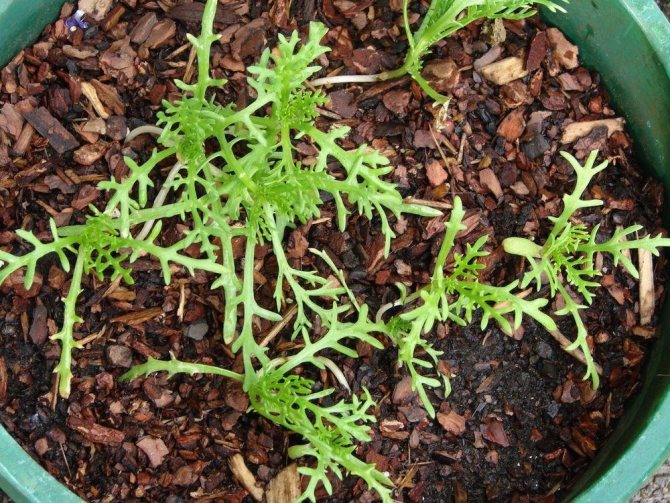

Daisy shoots two weeks before disembarkation
In the open field, under normal weather conditions, annual daisy bushes should be at a distance of 10-15 cm from each other. It is at this distance that they are planted on a flower bed.
Further, they themselves will regulate the optimal distance, but for high-quality flowering, you will still have to thin out the bushes.
When transplanting to a permanent place, it is worth considering the short stature of the plant, daisies are usually planted in the first row in multi-layer flower beds, on the lower tier of rabatok and alpine slides. If you plan to set up a wide flower bed, then the daisies should be near the very edge, otherwise they will simply be drowned out by the rest of the inhabitants.
When transferring seedlings from a container to open ground, you should carefully monitor the weather, the process itself looks like this:
1In the selected place, grooves are made
2Each one is watered abundantly
3 Seedlings are watered too
4Carefully pull the seedlings out of the container, make sure not to damage the root system
5Put the babies into the grooves
6 Sprinkle with soil and lightly tamp the earth around each of them
7 Watering will be the final stage of planting
If you plan to grow plants in pots and pots on balconies and terraces, then they will not need a transplant. It is enough just to thin out the seedlings, leaving the strongest specimens
back to menu ↑
See also: Cherry: a description of the 20 best varieties, characteristics and reviews of gardeners |
Post-transplant care
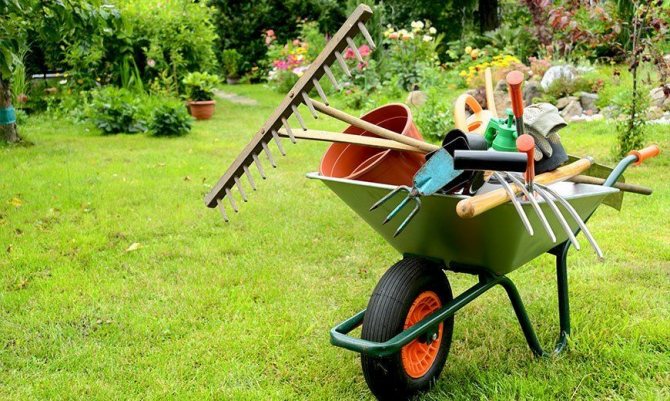

Care tool
After transplanting, for a successful rooting, a florist should make some effort. Plants will quickly die without supervision, only the strongest will be able to survive.
To speed up rooting and prevent the death of sprouts, it is worth taking the following actions:
- water as the soil dries
- protect from direct sunlight, slightly shade the landing site
- once a week, slightly loosen the ground around the boles
It is not worth feeding the seedlings at first, this can adversely affect their development, and a high concentration can even destroy plants.


Daisies in pots will only require watering and shady places, they will already have everything else
back to menu ↑
See also: Growing potatoes from seeds: is it necessary? Full description of the technological process, suitable for this variety + Reviews
Other types of reproduction
Daisies can be propagated not only by seeds, dividing the bush in the autumn or spring will help with this. The time for the procedure should be chosen so that the plant has time to take root before the onset of frost or extreme heat, most often it is the first half of May or the end of August.
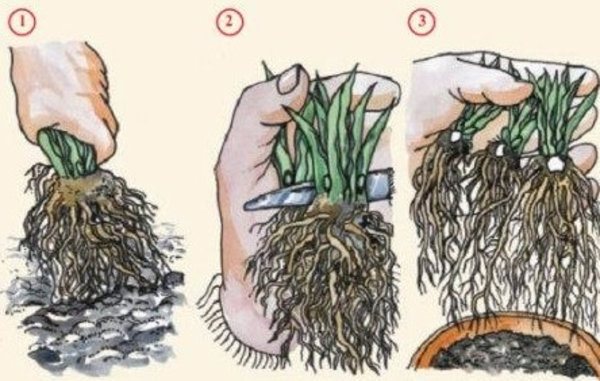

Dividing the bush
It is during this period, before or after flowering, that lateral shoots are actively developing, which are usually separated to rejuvenate the stem or plant a large area of the garden with it.
It is necessary to divide the bush correctly:
- it is advisable to dig it out completely in order to better draw the conditional lines for division
- when dividing, it is important to take into account the state of the horse system, in each separated mini-bush there should be well-developed roots
- the presence of lush foliage is not necessary, even from one leaf with strong and healthy roots, a full-fledged bush will quickly develop
- after separation, it is advisable to treat the cut with charcoal or sprinkle them with ground cinnamon
- seating the separated parts is in grooves, it is advisable to make them 3-4 cm deep
- watering during planting is carried out with sufficiently heated water
- as soon as the water is absorbed, the grooves are covered with soil and lightly press down on it around each plant, forming a small depression for watering
- after 2-3 weeks, the separated bushes will take root and begin their development
If the section of the bush took place in the spring, you should not wait for flowering this year, but next spring the daisies will delight you with exuberant flowering, which will repeat in late summer and early autumn. Separated in the autumn and having time to take root, they will bloom in the coming spring, if wintering goes well.
back to menu ↑
See also: Weigela: description, types and varieties, planting in open ground and proper care of the plant (60 Photos & Videos) + Reviews
Choosing the soil and landing site
Almost any soil is suitable for growing daisies in the garden and flower beds, the main condition is excellent drainage and sufficient nutrients.
If water stagnates at the place of growth in the spring or during the rain, then the daisies will not take root there, they will get wet there. But the lack of moisture in the summer heat can also ruin beauties.
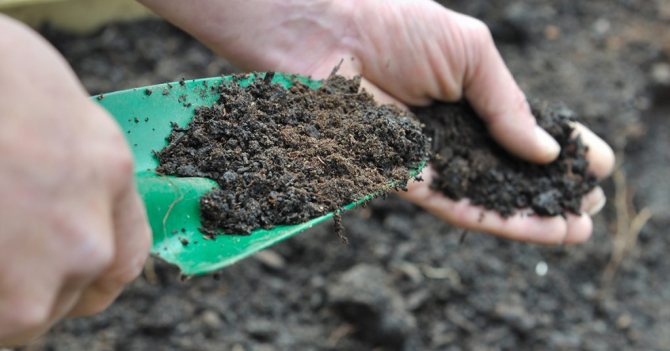

Preparing soil for planting
When choosing a place for planting garden beauties, it is worth considering some of the nuances:
- daisies do not tolerate direct sunlight, they are destructive for them
- the plant will feel great in partial shade and shade
- places that are flooded in spring are also not suitable, daisies will just get wet
- lack of moisture in the summer will destroy the plants
So that the boles feel good, grow and develop, it is worth preparing a soil mixture consisting of 2 parts of sand, 4 parts of garden soil, 1 part of humus. All components are well mixed and fall asleep in the place where the prepared seedlings or purchased bushes are planned to be planted.
Plant feeding should be carried out periodically., this is another component of regular flowering.
back to menu ↑
See also: Pansies: 10 species, a description of the process of growing from seeds in the open field and seedlings at home, the use of flowers (60+ Photos & Videos) + Reviews
Top dressing
All plants in the garden need moisture and nutrients for normal growth and development., without these components, most plants will not have normal flowering, which means that seeds will not be able to form. Garden varieties of daisies are no exception, they also need feeding.
After transplanting into prepared soil, in which one of the components was a small part of humus, at first there is no need to feed the plants, but in the future, after about a month and a half, the stems must be periodically watered with the addition of mineral fertilizers.
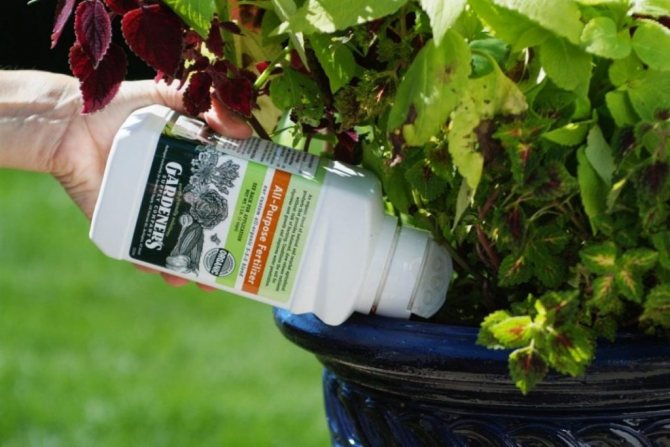

Fertilization
For further support, daisies are fertilized every two weeks., while the advantage should be given to water-soluble drugs with a high nitrogen content.
To feed the daisies, 10 liters of water are enough, in which 20 g of the substance was dissolved.
The second year of life for daisies begins with feeding in early spring.... The solution is prepared according to the standard proportions for the plant, then fertilizers are applied every 2-3 weeks until the fall. Particular attention is paid to the flowering period, where you can feed more often.
Several times throughout the season, gardeners recommend feeding with organic matter, most often for this type of garden flowers, an infusion of chicken droppings or mullein is used. Prepare the product in a ratio of 1:10, if you increase the concentration, you can burn the bushes, so strictly monitor the amount of the substance added to the water for irrigation.
Further care
In order for daisies to bloom on time, planting and care must be accompanied by abundant watering, especially in windy and dry periods. Without this, the plant will begin to shrink over time and sooner or later will die. It is important to thoroughly drain the soil before each watering.


Flower bed decoration with daisies
Cover crops with a layer of dry leaves before the onset of winter.
The plant does not need special shelter in winter and can even keep leaves and flowers under a layer of snow. The root system of young plants is vulnerable to negative temperatures; they need special care. It is advisable to add peat under such crops.
Wintering
Daisies are among those types of garden flowers that endure a dormant period in the ground, they are not dug up or hidden from snow and frost. Almost all varieties tolerate winter normally in the middle lane and to the south.
If daisies are grown in more northern areas, they need help with wintering:
- the bushes are sprinkled with earth a little and sprinkled with dry leaves or covered with spruce branches;
- warming daisies with dry sawdust would be a good option; in addition, you can cover the places of residence with film;
- dry foliage and agrofibre can also prevent freezing.
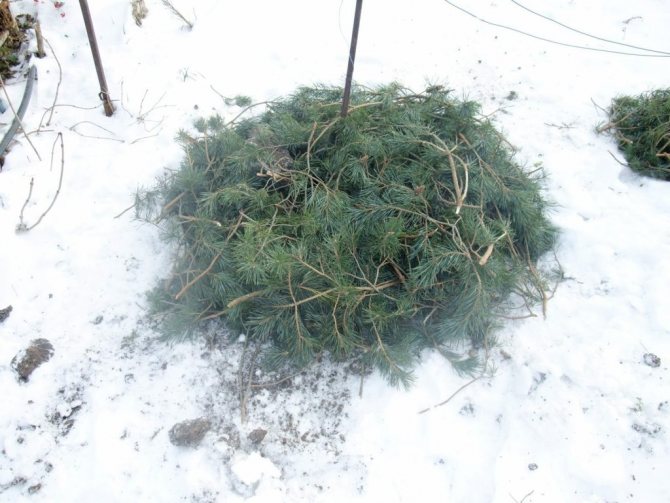

An example of sheltering needles of plants for better wintering
It is advisable to place the stems grown on balconies in pots and containers in dark rooms with an air temperature of 3-8 degrees. At the same time, minor fluctuations in the minus side will not be able to kill the bushes, but if the frost lasts more than 5 days, then you can say goodbye to daisies.
During the wintering period of flowers in pots, watering is minimized; it is enough to slightly moisten the ground once a month. There is no need to feed and spray the containers, and the ground part itself is cut off completely.
For germination, daisies in pots are exposed to the sun at the beginning of March, watering is intensified, and fertilizing begins. Usually, plants quickly respond to the favorable conditions created for them and actively begin to drive out the leaves at once, and then the peduncles.
Daisies bloom in containers earlier than in the open field, but the duration is much shorter, and the flowers themselves are small.
back to menu ↑
Read also: Periwinkle: description of the main species, recommendations for care and reproduction, medicinal properties (50+ Photos & Videos) + Reviews
Preparing for landing
In terms of soil, daisies are unpretentious - any soil is suitable, except for too alkaline and acidic. Before planting the plant, it is necessary to provide good drainage so that the roots can breathe and moisture is retained in the soil.
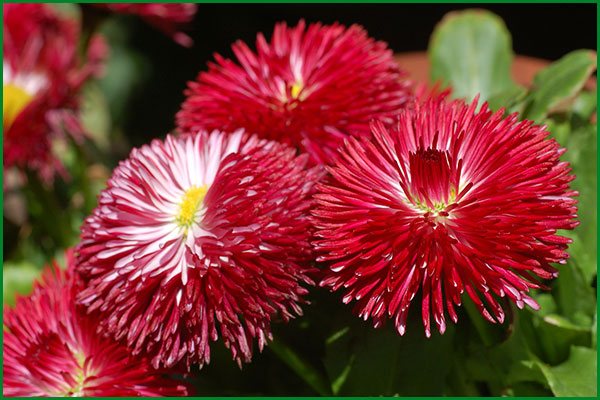

Daisies Tasso Red
Before sowing the seeds, the soil can be treated with a herbicide to remove weeds. To provide air to the plants, the soil must be loosened to a sufficient depth and all small debris - pebbles and roots - are removed.
Ideally, you can prepare a moist substrate containing a minimum of salts with an acidity level in the range of 5.5-6.2.
Daisies show good resistance to frost, therefore, cultivation and care can be carried out even in the northern regions. Nevertheless, it is better to choose a sunny place for planting - a flower to love an abundance of light. The best place for planting is the east or south side of the site, so that the plant receives maximum light. It is better to place a flowerbed or a hill away from trees and shrubs that can block the light.
Neighborhood in flower beds


Beauty from different types of flowers (Daisies and Lupins)
As already mentioned, daisies are most often used in multi-layer flower beds, but they do not manage to get along with the seven kinds of flowers. Because of some plants, they wither, and sometimes nearby planted stems die because of them.
That is why it is worth knowing the right neighborhood, which will help form a beautiful flower bed. Correctly selected plant species will get along well together, support each other.
The most beautiful and correct is the neighborhood of daisies with wildflowers:
- Daisies with forget-me-nots on the same level look great in garden design. The next row can be formed from tulips and daffodils, and further neighbors will not have any influence on the daisies.
- The flowering period of garden violets and daisies is almost identical, they will not only not interfere with each other during development and flowering, but will also create a natural composition of a flowering meadow or forest edge. These two flowers often coexist in the wild, so it is correct to place any flower bed in the foreground. Behind them, you can plant primroses, hyacinths, crocuses.
Planting daisies next to snowdrops and sleep-grass is not worth it, these flowers have a detrimental effect on each other.
back to menu ↑
See also: TOP-20 Primroses: flowers blooming in spring (March, April, May). Description and characteristics, recommendations for care (120 Photos & Videos)
Let's summarize
With the correct observance of the listed agrotechnical measures, daisies will grow strong, healthy, not requiring therapeutic and prophylactic measures.
An ornamental, perennial plant that is very popular among summer residents is astilba.In a special article, we will talk about how to plant astilba in your garden plot, and how then to care for the plant so that it does not lose its decorative effect, does not hurt and pleases with lush flowering.
Video - Growing daisies from seeds
Diseases and pests
Like any garden plant, daisies are susceptible to disease and pest attacks.... If you do not help the plant in the fight against them, then over time the stem will be completely lost, and the infection will spread further.
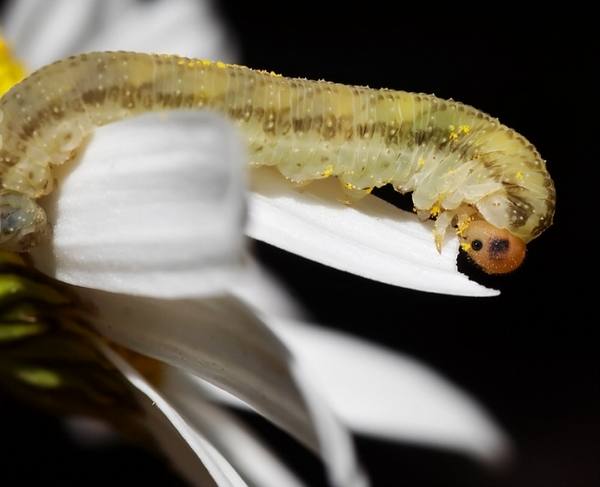

"Murder" of a blooming daisy
To avoid such an outcome and to preserve all the available types and varieties of flowers in the garden, it is worth learning to distinguish between ailments. A correctly selected method of struggle will also be important, because the future fate of the plant largely depends on the drugs used.
Most often, daisies and other garden plants suffer from:
Thrips These are small brown or yellowish insects, which choose the lower part of the leaves of the plant as a place of dislocation. Their presence is signaled by dark discharge throughout the plant, in addition, the leaves acquire a yellowish-brown color, which spreads chaotically and does not lie down evenly.
To save the plant from this trouble, all infected boles, as well as nearby plants, should be treated with insecticides. It is advisable to carry out prophylactic treatment 5-7 days after the first treatment.
Powdery mildew A whitish powdery coating on the leaves and flowers indicates that the plant is suffering from powdery mildew. There are not many methods of struggle; fungicides fight the disease best.
It will have to be processed several times at intervals of 6-9 days.
Brown spot It is manifested by the formation of parchment-like spots on the leaves. They quickly spread throughout the bush, so you need to act without delay. The main reason for the occurrence is the increased humidity of the soil and air, in order to preserve the bole it should be dug out.
Dry well and plant in looser soil in a ventilated place.
Gray rot In warm, damp weather, daisies in the garden can be affected by gray rot, most often they are observed on boles in the autumn and spring. To avoid the disease or reduce the possibility of its appearance, you can completely cut off the old leaves on the trunk for the winter, as well as the correctly chosen planting site.
If a disease is detected, it is worth treating the affected areas with Fundazol.
Caterpillars Many types of caterpillars like daisies, they eat their leaves with a special appetite. There are several ways to deal with them, either by regularly picking them by hand in the evening, or by periodically treating them with insecticides.
Before you start working with drugs that help to cope with these pests, be sure to read the instructions and strictly adhere to safety precautions.
Read also: TOP-55 Blue flowers and plants for your home and garden. Indoor and outdoor, perennial and annual (85+ Photos & Videos) + Reviews
Reproduction
Even without having experience and skills in floriculture, you can grow daisies, which are propagated by seeds. You can immediately plant them in the ground or pre-grow seedlings. Planting seedlings allows you to grow plants that are more resistant to weather changes and the effects of pests.
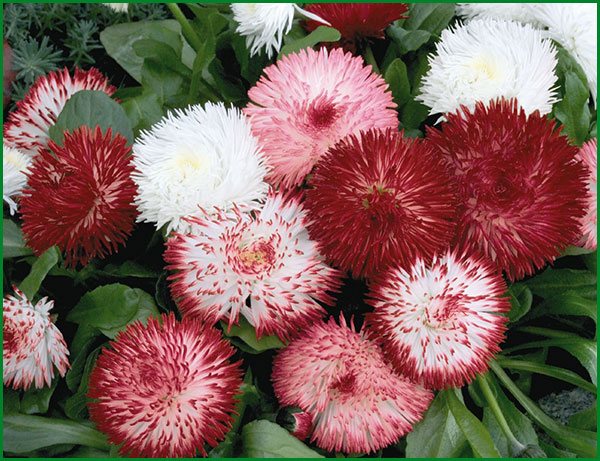

Daisy Habanera
More difficult is the propagation of a flower by cuttings or dividing bushes. Cuttings are used to propagate varieties of particular value.
It should be borne in mind that daisies reproduce abundantly by self-seeding, but this negatively affects the varietal qualities of the seed. To maintain the purity of a certain variety, individual shrubs can be transplanted, removing low quality flowers.
Seeds for planting should be collected from wilting inflorescences, dried in the sun. Planting material can be harvested throughout the entire flowering period.
Winter forcing daisies
In winter, you can get flowering daisy bushes. To do this, in the fall, they dig the required number of plants from open ground with a large clod of earth.
The material is placed in boxes or pots and placed in a cold room (basement, loggia) with a temperature of -1 ... + 1 degree. Occasionally they water it a little, just enough so that the earthen lump does not dry out.
6 weeks before the desired flowering time, the plants are brought into forcing in a warm, bright room and regular watering begins in sufficient volume.
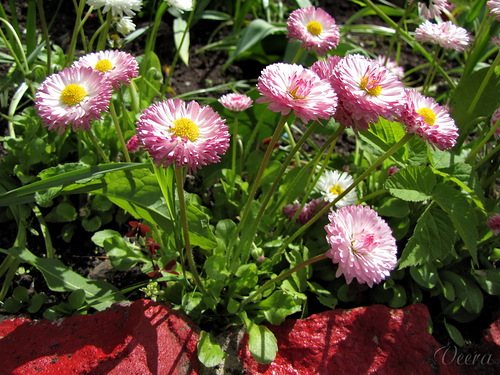

Photo credits: NatalyaLakomova, Nattina, Tatiana (♥ tatik ♥), veerra.
Transfer
This point of agricultural technology applies only to perennial varieties. The need for their periodic transplantation is dictated by the culture's tendency to degeneration. At first, the planting pleases with the beauty of large double flowers, and after a few years there is no trace of the former decorative effect in the same place. As soon as the curtain begins to grow, the flowers become smaller, their double qualities disappear. And, if other flowering crops require a rejuvenating transplant not earlier than in 5-6 years, then daisies need it much more often. If it is not possible to make a transplant with dividing the bush, then you should at least remove the extra bushes. This is a rather troublesome, but necessary point of care.
Description of the plant
The graceful bellis, or more commonly, the daisy is a perennial herb of the Astrov family, a frequent and welcome guest of summer cottages and household plots. In nature, there are about 14 species, mainly growing in the Mediterranean. Bellis is considered the birthplace of Europe, from where it was brought to Africa, Australia and America.
Actually, this flower has many names:
He received the Latin name "Bellis" between 22 and 24 AD from Guy Pliny Secundus, or Pliny the Elder, who wrote the epic work "Natural History", which consisted of 36 volumes. Bellis is translated, simply "beautiful".
Margarites is an ancient Greek word and literally translates as "pearl".
The British, too, were not too lazy to come up with their own name and called it "Day's eye", or "Eye of the day", abbreviated as Daisy.
And that is not all. Romantic German girls used daisy inflorescences for fortune telling, similar to how chamomile is traditionally used for this superstition in our days. From this, in Germany, the plant received the name "measure of love".
Outwardly, daisies look simple and elegant at the same time: they grow mostly not tall, at the base of the stem there are several large blunt spatulate leaves, there are no leaves on the stem itself, and one small inflorescence adorns its top.
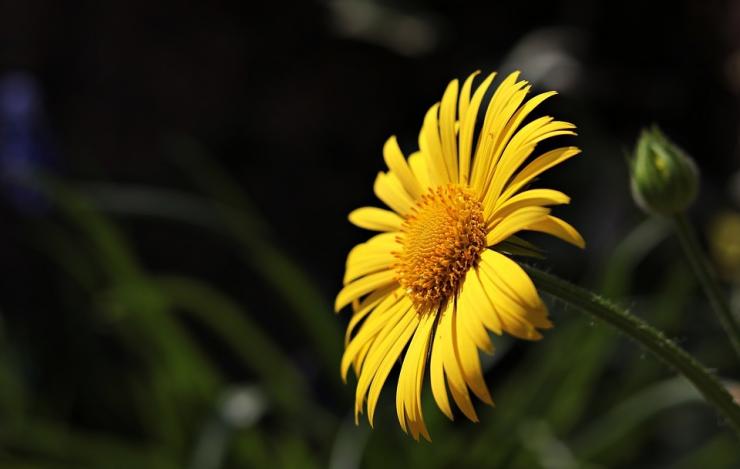

Types and varieties
The daisy (Bellis) belongs to the Asteraceae genus, which numbers more than 30 species. Flowers differ in the shape and size of the inflorescences. Terry varieties of culture are especially popular.
Annuals
The annual daisy (Bellis annua) is a wild flower. It is found mainly in sections of forest clearings or along roads.


The plant has the following characteristics:
- small height;
- small double inflorescences;
- white-pink or white color of the baskets.
The culture blooms by the end of summer and continues to release inflorescences until the first frost.
Annuals are mainly used for breeding in indoor pots.
Perennial
Bellis perennis (Perennial daisy) is cultivated as a biennial. The flower is widely used in the design of balconies, greenhouses or as an element of group plantings in landscape design. On the basis of this culture, all modern flower varieties have been bred.
Depending on the appearance of the inflorescences, there are:
Flowers of both varieties are:
The most popular varieties are:
- Daisy Habanera (Habanera) - characterized by large double pinkish or red inflorescences about 8 cm in diameter and stem height up to 16 cm.
- Belladaisy is an early, low-growing variety that stands out with a rich red or pinkish shade of inflorescences, the diameter of which can reach 2.4 cm.
- Bellissima - blooms in the first year after planting in large (up to 5 cm in diameter) baskets of white, bright red or pinkish color. The stem of the plant grows up to 12 cm.
- Rominetto - reaches 2 cm in inflorescence and 15 cm in height. It is characterized by red, purple or pink flower buds.
- Rob Roy - does not grow more than 10 cm, but stands out among its congeners with 2-cm scarlet inflorescences.
- Daisy Robella - is distinguished by a bright salmon color of petals. The diameter of the inflorescence is 5 cm, and the stem height reaches 18 cm. Robella is one of the most popular varieties.
- Tasso - has large 6-centimeter inflorescences of white, scarlet or pinkish shades. The petals are collected in tight, connected baskets.
Popular varieties of daisies in the photo:
Flowers look great in flower beds in combination with bushes of violets, tulips, forget-me-nots, daffodils, lily of the valley or viola.
Planting and caring for perennial daisies outdoors
At home, in addition to breeding daisies with seeds, they use the methods of grafting and dividing the bush. In this way, the planting material is harvested after the plant has faded. The principles of cultivation of these specimens coincide with the features of planting ordinary seedlings.
The prepared daisy seedlings are transplanted into open ground a month after the pick. Open areas with loamy drained light soils and bright lighting are chosen as a permanent place of growth. It is possible to grow flowers on sandy soil, subject to the introduction of manure, leafy soil, humus, ash and peat.
Fertilizing and feeding daisies
Experienced growers advise to fertilize this ornamental plant 3-4 times throughout the season.
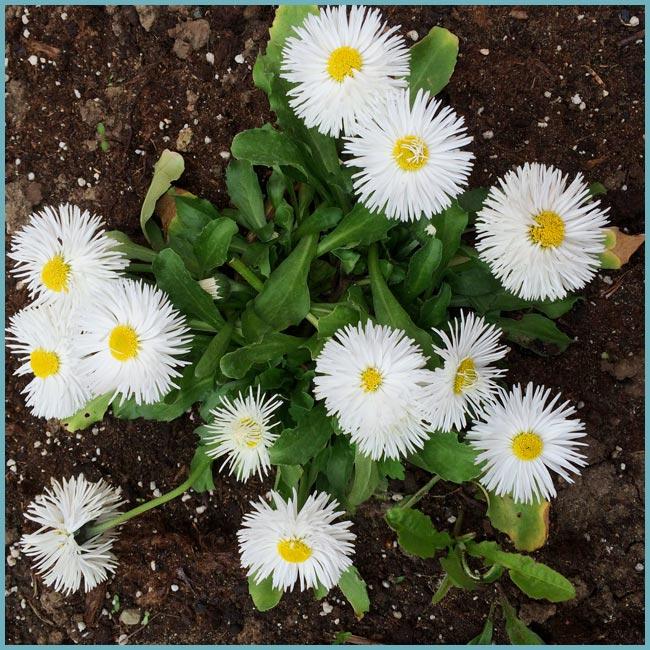

Mineral fertilizers are necessary for the plant, especially during the flowering period.
- Apply the first top dressing in the spring as soon as the snow melts. Sprinkle urea (urea) on the daisy beds. This nitrogen fertilizer will provide the necessary nutrition for actively growing flowers.
- In the summer, when young inflorescences appear, feed the bushes with mineral fertilizer. For example, nitroammophos.
- During the flowering period, phosphorus and potassium are useful for daisies. The last feeding of the season should also consist of their combination of these substances.
Advice. Daisies bloom from May to July. In the middle of summer, cut off the inflorescences, apply fertilizer. This will stimulate the plant to bloom a second time in September.
What kind of care does the culture require?
To improve flowering and its duration, you should carefully study the care of a decorative daisy. So feeding is carried out from the moment of planting.
Covering material becomes top dressing, which turns into a mulching agent. Watering must also be done correctly. After all, excess liquid is always harmful.


Watering
The daisy loves water, but waterlogging harms the root system. Therefore, it is recommended to water the plant daily, but according to the principle "it is better to underfill than to overfill." In a drought, in the absence of watering, the flower dries up. Due to this, the inflorescences become smaller, lose brightness. Gradually die off.
To retain moisture, it is worth making a drainage layer. With its help, the roots are better nourished, provided with oxygen.
Top dressing
Delicate daisies and at the same time strong ones do not always require fertilizer mixtures. It can kill them if the dosage is overestimated.
Combined substances are suitable for a flower: Nitrofoska + Agricola, 2 tbsp each. l. diluted in 10 liters of water. During the growing season, it is enough to carry out 3 procedures.


Weed removal
Daisies grow in any soil, they get along well with other plants. But the weed is able to clog the plant and prevent it from developing fully.
Weeds should not be allowed to grow next to flowers. Therefore, regular cleaning will help preserve your garden decor.The grass is pulled out carefully so as not to catch the seedlings or an adult plant.
Step-by-step planting instructions
Most gardeners tend to cultivate daisies as a 2 year old plant. If you follow the suggested instructions, in the last week of April you can enjoy a lush bloom, lasting until the first frost. Both seeds and seedlings are planted in open ground. This article discusses both options.
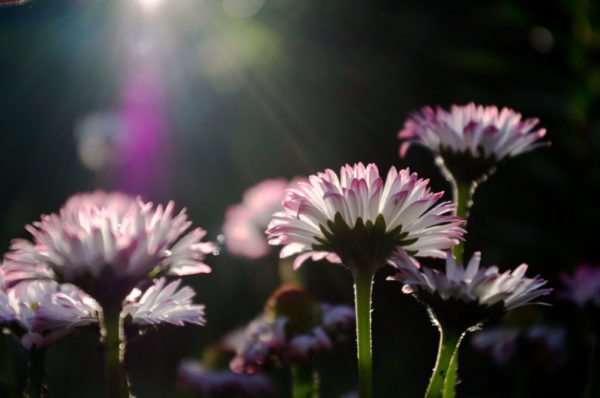

The first wave of flowering of many varieties begins in early spring.
Photo 5. It is advisable to plant perennial crops in the garden.
Step 1. Selecting a variety
Among the most popular, there are two types of varieties.
Reed:
- Bellisima. It reaches a height of 15 cm. Terry flowers are completed in baskets in the form of pompoms. The diameter of the inflorescences is up to 4.5 cm. The color of the petals is pink or scarlet.
- Rominet. Small, grows only up to 12 cm. Densely double inflorescences rest on powerful peduncles. Carmine flowers.
- Pomponetti. The variety, bred by French breeders, is the owner of miniature inflorescences. During the flowering period, up to 40 flowers are formed on one crop.
- Speedstar. The height of this variety type is about 13 cm. The petals are semi-double, mostly yellow. Flowering occurs in the year the seed is planted. The petals are painted in pale pink, snow-white or carmine colors.
- Habanera. The owner of large double inflorescences up to 6 cm in diameter. Outwardly similar to asters. Flowering begins in early June.
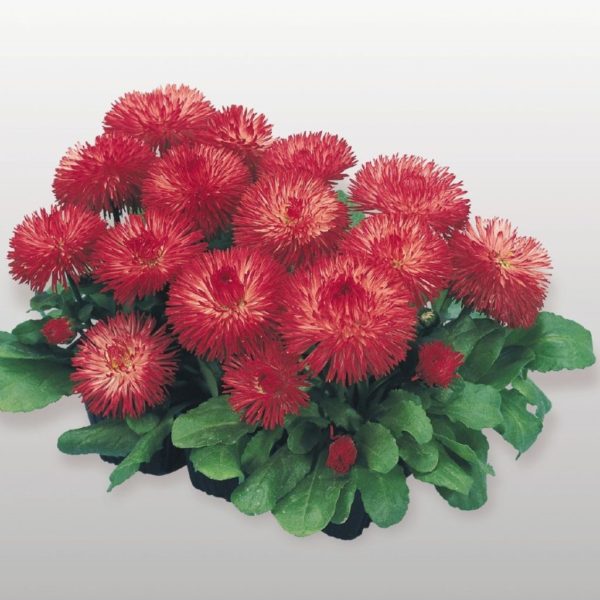

Tubular:
- Rosabella. Large double inflorescences are painted in a salmon shade. The diameter of the flowers is about 5 cm.
- Bella Daisy. Differs in early flowering. The flowers are arranged in a pink terry basket, the diameter of which does not exceed 2.5 cm.
- Robella. The height of the plant is 15 cm. The color of the petals is from coral to pale pink. The diameter of the terry baskets is up to 5 cm.
- Rob Roy. The culture is small, reaching a height of only 10 cm. Miniature inflorescences, up to 2 cm in diameter, are painted in a rich scarlet color.
- Tosso. The owner of large inflorescences, up to 6 cm in diameter. Pink, scarlet and snow-white inflorescences form baskets tightly fastened to each other.
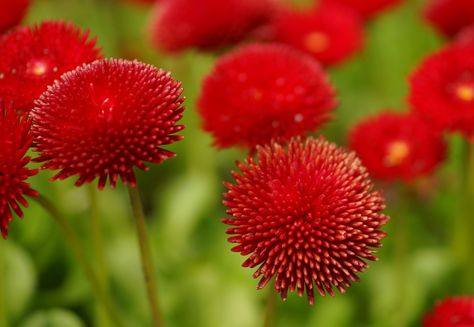

Step 2. Determining the sowing time
Seeds are placed in open ground in June. If you plan to grow by seedlings, then the seed is sown in containers in February or March, and the sprouts are transferred to the soil in the fall. This method allows you to achieve the first wave of flowering in the current season.
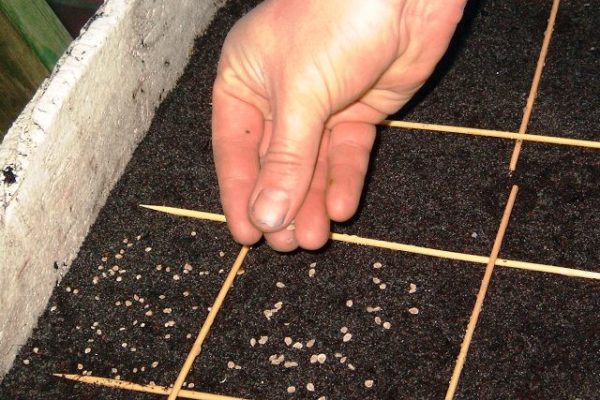

It is better to sow seedlings in February.
Step 3. Choosing a location
The plant belongs to the category of light-loving. However, slight shading is not a hindrance. On a darkened area, it will not delight with lush flowering, but the flower stalks will be tall and the leaves are tender. The sun promotes intensive formation of inflorescences, but the plants will be short. The optimal area is considered to be outside the zone of exposure to midday rays.
Due to the fact that daisies react negatively to dampness, it should be checked that groundwater does not pass directly near the surface.


The daisy cultivation area should not be in the shade
Step 4. Preparing the soil
The soil must be properly cultivated and drained. Optimum pH values are from 5.8 to 6.2. The priority is structured, light loam. They give the plants the right amount of moisture. When planning to grow this crop, it is advisable to feed the land with rotted cow dung in the fall.
For these plants, excessively moistened soil is more dangerous than dry soil. In places of stagnant melt water, daisies fall out of the ground. To avoid this, the land must be drained.


Mullein fertilizer
Step 5. Seed preparation
Species daisies reproduce well with seeds. For cultivation, both purchased and manually collected planting material are used.
When self-harvesting, you cannot take seeds from hybrids. The plant may lose its original characteristics.This applies to the color of the petals, the diameter of the inflorescences and the growth of the crop.


Collecting seeds after flowering
- It is carried out gradually, several times a week.
- The weather should be clear before the onset of the seasonal rains.
- The required number of wilted baskets is cut off.
- The seeds are removed and placed on a white sheet of paper.
- Placed in a room with good ventilation.
- When dry, they are folded into paper bags.
The seeds of daisies are very small, in 1 g there are up to 1 600 pieces.
How to grow daisies on a windowsill, on a balcony in a pot?
You can also grow daisies at home. The easiest way to do this is by digging a bush of these flowers from your garden and planting them in a large pot. This is best done in autumn, when the average day temperature drops to +8 degrees.
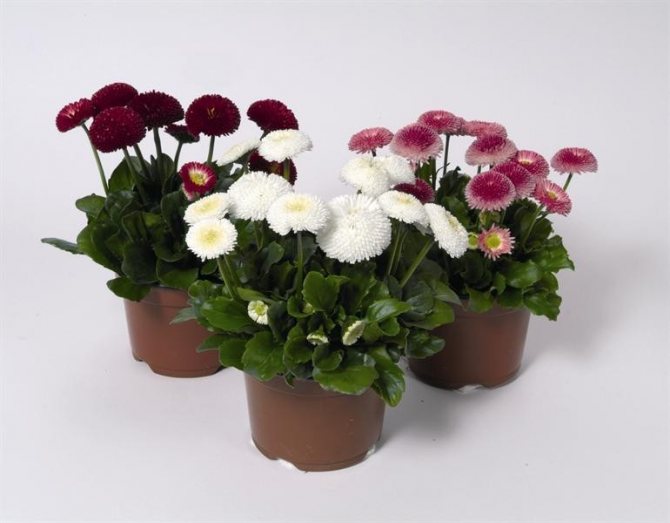

Daisy in pots
Prepare a bud that is favorable for this flower. It should be loose and fertile. Add humus and sand to such soil. The pot with the transplanted plant should be placed near the window. Then the daisies will receive the necessary amount of light and will bloom in December.
If you plant daisies in seed pots, they will begin to bloom only next year. The best time to plant the seeds of this flower is March-April. Pots or boxes of seedlings should be placed on a sunny window and watered sparingly.
When the first true leaves appear on the seedlings, they can be planted in separate pots or transplanted into containers for several shoots. When rosettes appear, daisies can be grown like other house flowers.
In order for the daisies to bloom profusely next year, they need to be placed in a cool place in November and watering should be reduced to a minimum. At the end of February, the plants are again placed on the windowsill and watered normally.
For a flower garden on the balcony, it is best to choose special containers for daisies that are sold in hardware stores. And in order not to waste time watering these plants, you can buy and install special automatic systems for moistening the earth.
The best varieties of perennial daisies
Originator Benary:
Series ‘Habanera’ Terry baskets claim to be a record: their diameter is 6 cm and more!


Habanera Series
An attractive feature: the baskets are less dense than those of other terry varieties, and appear slightly delicate due to the slightly curved "petals". Height 15 cm. Colors: white, pink, red, white with red tips.
Series ‘Robella’ Densely double baskets with a diameter of 4-5 cm, a unique salmon pink color. Height 12-18 cm. Gold medal "Fleroselect".
Series ‘Speedstar’ Baskets are semi-double with a bright yellow disc, especially expressive in the variety with carmine flowers. It blooms without vernalization, that is, in the year of sowing, without requiring a cold (winter) dormant period. Colors: carmine, pink, white. In pink-flowered baskets, the disc is surrounded by a white halo. Height 13 cm.
'Rominette' series Small dense double baskets with a diameter of 2 cm. Colors: white, pink, carmine pink, red. Height 12-15 cm.
Series ‘Tasso’ Baskets of tubular flowers, deep double, extremely dense, 4 cm in diameter, pompom type, on short sturdy stems - a modern improved version of the old ‘Pomponette’ variety:
- 'Tasso® Dunkelrosa' red
- 'Tasso® Erdbeersahne' salmon pink
- 'Tasso® Hellrosa' pink
- 'Tasso® Rot', red
- 'Tasso® WeiB', white
- 'Tasso Strawberries & Cream', a light pink with a darker center.


Variety from the Tasso series
The series has been awarded with Fleroselect awards. Height 12-15 cm.
Floragran originator:
‘Belladaisy’ Newly awarded Fleroselect. Terry baskets with a diameter of 2-2.5 cm, the color is bright pink. Height 10 cm. Differs in early flowering, uniform habit and stable color of baskets. From sowing to flowering - 70-120 days, depending on the timing of sowing.
Originator Kieft Seed:
Series ‘Bellissima’ Baskets are pompom type, terry, up to 4.5 cm in diameter. Height 12 cm and more. The variety is early, does not require vernalization, blooms in the first year. Colors: red, pink, pink two-tone with a darker center, white.
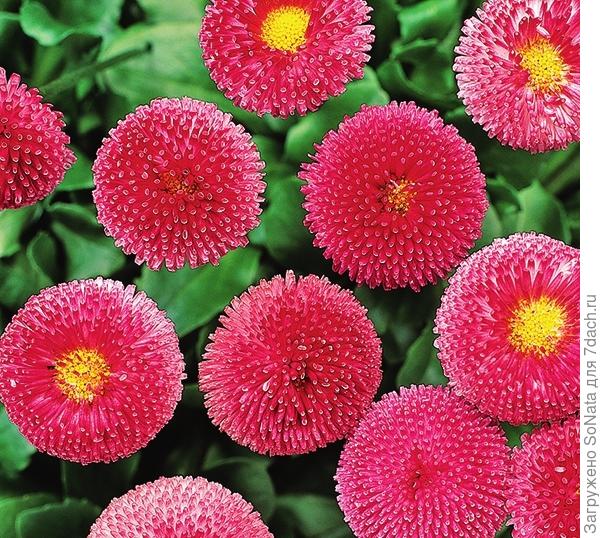

Bellissima Rose cultivar
Daisies: photo
Seat selection
The place for planting daisies is selected, first of all, based on their decorative purpose, so you should be prepared for the fact that the composition of the soil at the selected location will have to be optimized for this culture. The question is simplified by the fact that daisies do not impose great requirements on the soil. But they feel best of all on light loam. In this place, water should not stagnate; in the lowlands, you need to take care of its high-quality and timely outflow in advance.
As for lighting, daisies are also unpretentious here. They are ready to grow in an open area with sufficient moisture, and in a small passing shade. Perhaps all the difference will be only in the height of the peduncles, in the first case they will be shorter, and the leaf rosettes are denser.
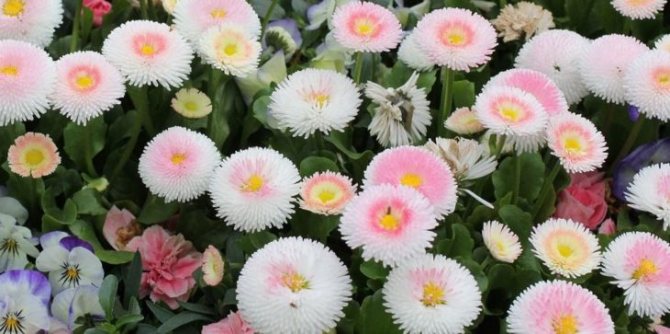

Daisy in landscape design


Daisy looks great with other low-growing crops
In large areas, the daisy looks beautiful like a carpet of fresh flowers. Due to its low height, it is often planted along curbs, on flower beds, lawns and in a portable garden (it can be arranged in a barrel, trough, plastic dishes).
Often in landscape design, home ponds are decorated with a daisy. It is planted along the banks or in waterproof containers that float on the surface of the pond.
How your flower garden will look like depends on your imagination and desire. Take good care of your daisy and it will reward you with long, abundant, lush blooms.
Spectacular variety
The scientific name of the perennial daisy Bellis perennis is translated as "beautiful perennial." In the 17th century, two-colored daisies appeared with speckled petals and stripes, red on the top and white on the bottom. In Italy, varieties with lancet baskets of tubular flowers were bred. The 'Pomponette' daisies with small pompom baskets were given to us by France.
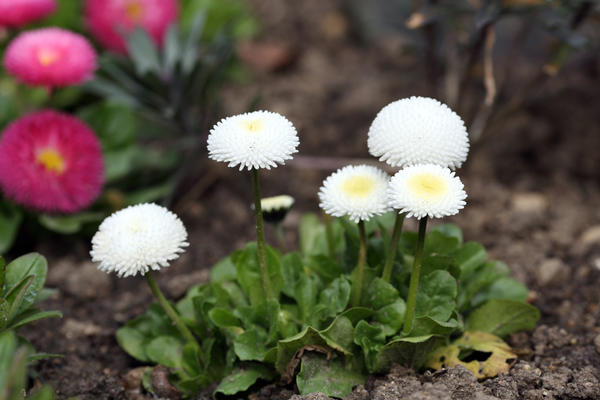

Daisies with small pompon baskets Pomponette
Nowadays, the color range has been enriched with rich dark reds and salmon pink tones.
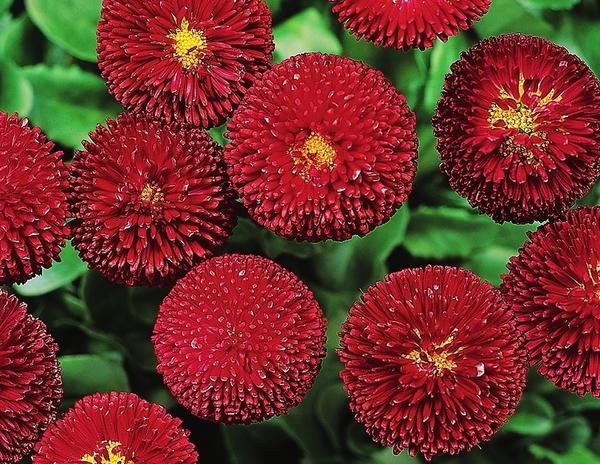

The dark red shade is sure to attract everyone's attention.
There are tiny varieties like ‘Dresden China’, ‘Liliput’, ‘Alice’, and giant varieties like ‘Habanera’.
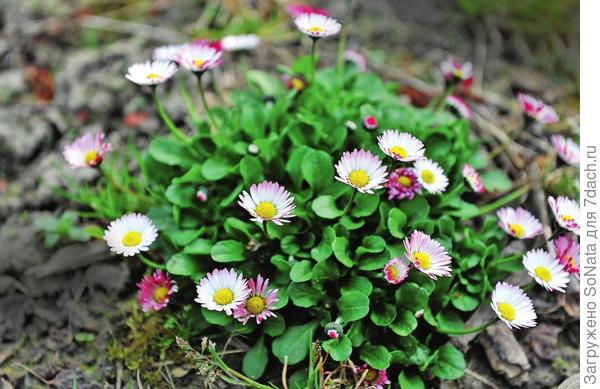

Adorable babies are a must in English cottage gardens.
In the curious 'Prolifera' variety, also known as 'Hens and Chickens' - "Chickens with chickens", the central basket is overgrown with a "nimbus" of small baskets of the second order, like a hen surrounded by chicks. (Depending on the length of the stems, this flower miracle looks like a graceful wreath of individual mini-daisies above a “mother's” basket or one, but large and shaggy terry daisy.) In daisies, the phenomenon of proliferation - the germination of inflorescences - attracted attention already in XVI century, which is recorded in the illustrations of old garden encyclopedias. It is surprising that the variety has survived to this day, although now this rarity is grown more for fun.
There are also daisies with unusual leaves - ‘Aucubaefolia’ with yellow splashes on the leaves, like the houseplant Aucuba, and ‘Shrewley Gold’ with a bright golden yellow pattern along the veins.
How to collect daisy seeds
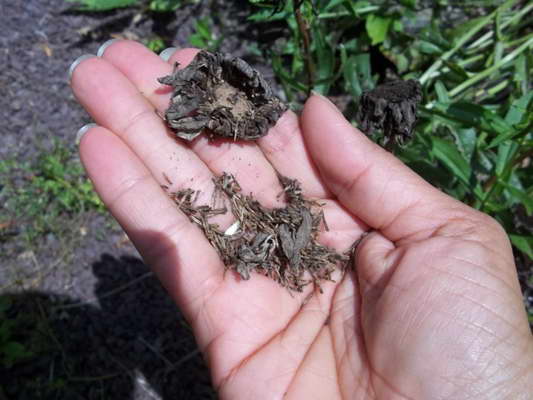

How to collect daisy seeds photo
Since with proper storage, the germination of daisy seeds lasts up to three years, it makes sense to collect and save seed material. One condition is that the seeds are harvested from non-hybrid plant varieties.
The rules for collecting seeds are as follows:
- seeds are collected only from faded inflorescences;
- flowers, laid out in 1 layer, are dried on a paper bed;
- dried until the seeds fall out of the inflorescences easily;
- store seeds in paper or cloth bags, which indicate the year of collection, the name and variety of the flower.
Growing Daisies: Tips & Reviews
Natalia. Very beautiful flowers. But, they need constant watering.Their root system is practically on the surface and when the soil dries out, the roots can be damaged. And such an arrangement of the roots does not give them the opportunity to endure dry days. We visit the country house only on weekends. Somehow they left and forgot to water. It was a dry week and our daisies were dry.
Svetlana. Very beautiful flowers. But, I heard that they are also very useful. On their basis, you can make decoctions that help with bronchitis and kidney disease.
Care
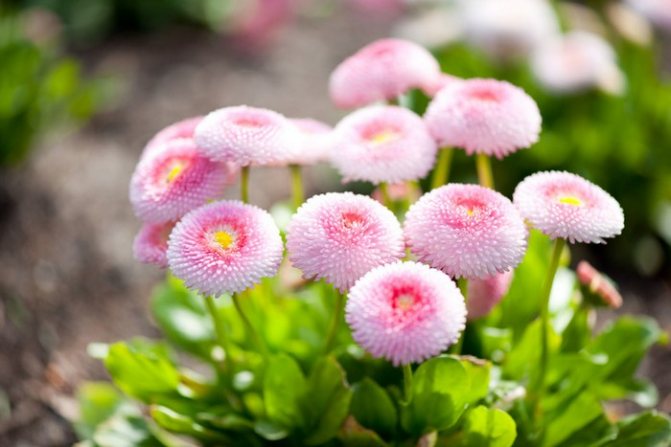

Perennial daisies will grow almost everywhere, as long as there is permeable soil and a little moisture. For a beautiful appearance, nutrients must be easily absorbed in the soil and there must be sufficient moisture. The best way is to replace the standard soil with compost. Compost has the ingredients a daisy needs almost all season and a high percentage of humus, it binds water in an ideal way. Watering may be required during summer drought. By digging a large hole, the roots will remain in the compost throughout the season.
Since in most cases the seeds of the varieties are not needed, since they do not inherit the characteristics of the mother plants. Therefore, peduncles are removed as they bloom. After flowering, old rosettes are removed. Daisies should be fertilized with nitrogen fertilizers to stimulate the growth of new outlets, to prevent flowering. Nitrogen promotes growth, but inhibits flowering, and is easily washed out of the soil. Phosphorus-potassium fertilizers are applied in early spring. Phosphorus promotes bud setting, potassium improves the quality and duration of flowering. After the end of flowering, repeat the feeding.


For growing daisies in containers, seedlings are purchased. When buying an interesting variety after flowering, you can transplant the bunches to the backyard so that the plants form new rosettes. In the spring, the rooted rosettes are transplanted into containers. With a large number of seedlings, beautiful combinations can be created, in containers and in the flower bed.
The substrate in containers should be loose and fertile, it is better to give preference to substrates of well-known companies, containing fertilizers with delayed action, frees from fertilizing during the season, the plant uses the supplied fertilizers in the right proportions. When using standard soil, fertilizing is applied after 6 weeks after planting. Fertilizers are applied to flowering plants to get longer flowering.
Seed collection
Daisy seeds are not given away amicably, but as they ripen over the course of a long flowering, so if you want to collect all the seed, you need to do it in stages every 5-7 days. It is necessary to carefully cut off the already wilted, but not yet scattered inflorescence seeds, drag them out onto paper and spread them out on it to dry. For storage, paper envelopes or bags are also used, which are left for the winter in a dry and dark place.
Do not water the daisies before picking; jets of water easily wash out the ripe seeds.
Daisy flowers - description
Daisies are small herbaceous plants with a short rhizome, blunt spatulate crenate basal leaves, and a leafless stem on which one head is formed. On the conical receptacle, female ligulate flowers of white or pink develop, the middle flowers are bisexual, tubular, yellow. The inflorescences of daisies grown in culture can be simple, double or semi-double, they can also vary in size. The daisy fruit is a flattened achene without a tuft.
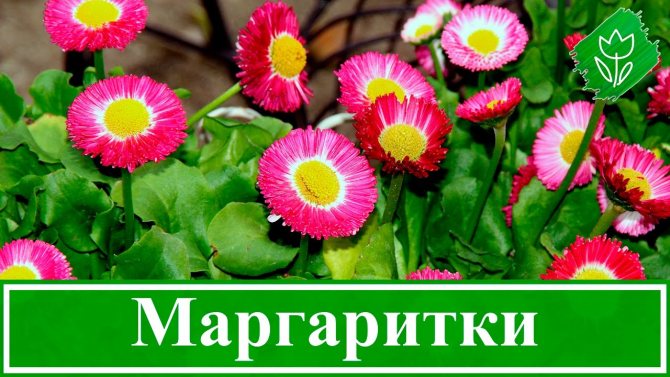

Growing perennial daisies from seeds
Species daisies reproduce well in a generative way. The time for growing flowers from seeds depends entirely on when the seedlings are planted in open ground. Sowing daisies between early spring and early summer is considered the best option.However, it is worth considering that carrying out the manipulation at the end of February will allow the plant to bloom at the end of this year.
When using this dilution method, the procedure is carried out as follows:
- For sowing, loamy soils are prepared or universal soil is purchased in the store.
- A drainage layer is placed at the bottom of the container to prevent moisture stagnation.
- Shallow pits are made in the prepared soil, while maintaining a distance of about 1.5 cm between them. Seeds are sown.
- The planting grooves are slightly moistened with water from a spray bottle. Then cover the container with a film or a lid.
- For about 2 weeks (before emergence) the temperature is maintained at about + 25 ° C. In this case, the daylight hours for the plant are extended to 14 hours.
- After pecking the first shoots, the air temperature is lowered to 15 degrees Celsius. Before planting in open soil (about 7 days), the seedlings are hardened.
The formation of 3 full-fledged leaves on the culture serves as a signal for picking.
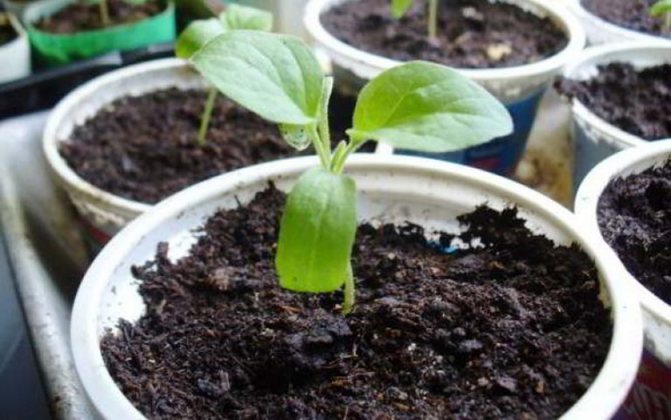

Direct sowing (in open ground) is carried out in early June using a similar technology. However, in this case, daisies bloom only in the next season.
Video from Yana Fedorova:
Growing and care
Choose a sunny place for daisies, because good lighting is required for generous flowering. Any garden soil will do, as long as it is sufficiently cultivated by cultivation and composting. At the same time, since daisies are sensitive to uniform moisture supply, they prefer light, structured loams.
Excess moisture is perhaps even more dangerous than lack of moisture. In low places where melt and rain water stagnate, these plants can fall out. Therefore, drainage is essential.
Daisies are winter-hardy. To survive the frosts safely, completely leaving under the snow, they are helped, among other things, by their small "growth". But where they are planted on a hill, for example on a hill, and where snow blows off in winter, it is advisable to lightly cover with an oak leaf or spruce branches.
Daisy care
Daisies are surprisingly unpretentious, they can survive drought and other adverse conditions. A vivid proof of this is the flowering semi-wild lawns, colored with a mass of tiny "daisies". Here, daisies do not get any care at all, if only the lawn is green. Perhaps the only exception is that faded baskets of daisies are cut at the same time when cutting grass. That's all the care! And daisies bloom even more! At the same time, in close company with lawn grasses, daisies are never as good as, say, in the border around a flower bed, where they are looked after like garden flowers - weeded, watered and fed on time.
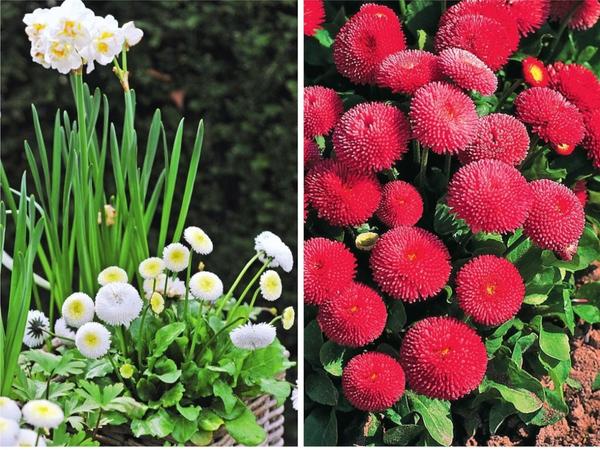

Left: Daisies are great companions for bulbous plants. Right: Most often, daisies act as a border for flower beds.
On the lawn, they differ little from their wild relatives in the mountain meadows of the Crimea or the Caucasus. Only on a high agricultural background are the varietal advantages fully revealed, and the plants bloom for a long time. Therefore, in the spring, do not be lazy to feed the daisies with a balanced flower fertilizer, and during flowering, do not allow the plants to set seeds - pinch off the withering baskets. For plants, this serves as a signal that the attempt to leave offspring has failed and must be repeated, which, of course, significantly lengthens the flowering period.
Daisy: combination with other plants
Daisy goes well with other primroses: hyacinths, tulips, daffodils. A successful combination with pansies, violets and forget-me-nots. The daisy looks elegant and elegant in the company of ferns and stunted conifers.
Advice. The plants you combine should have the same care and similar requirements for light, soil quality, and watering.

